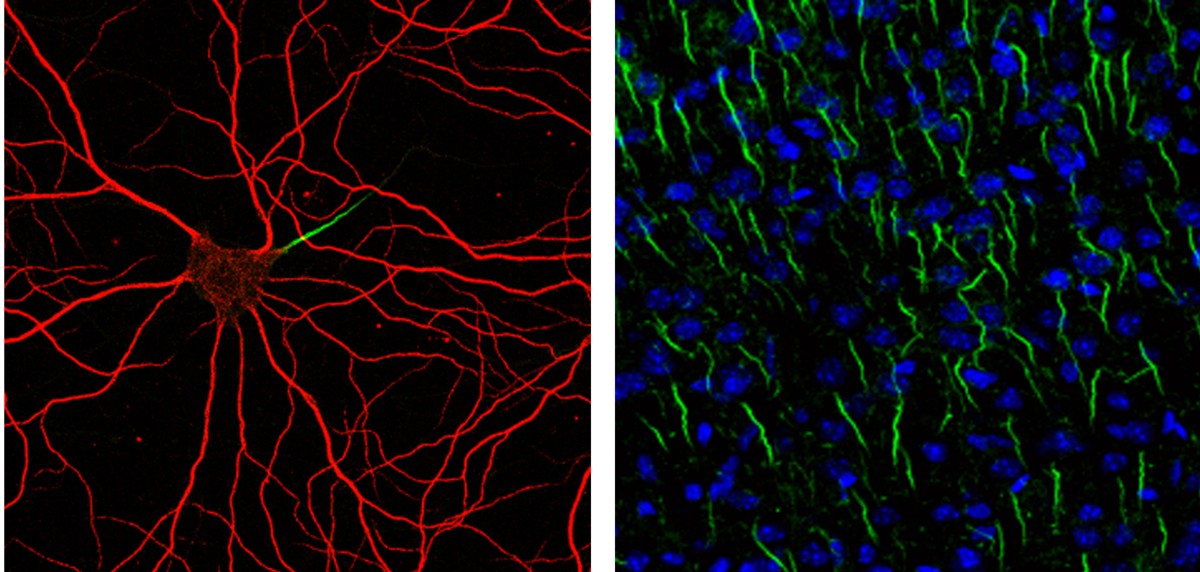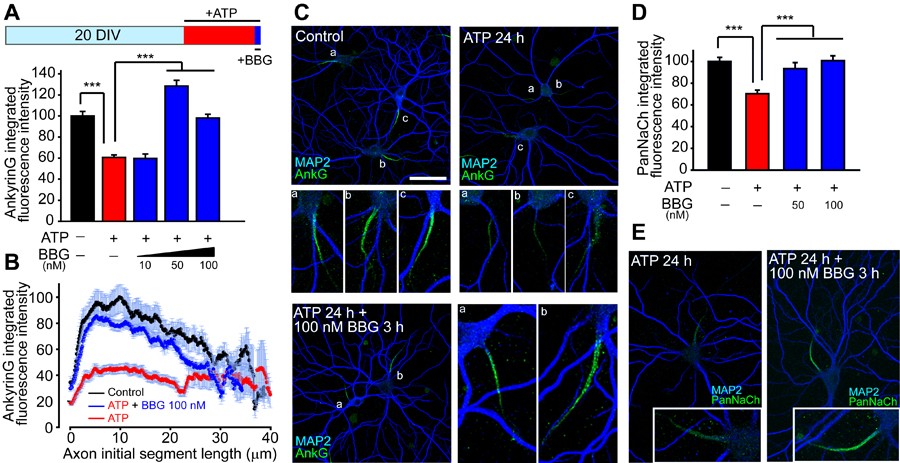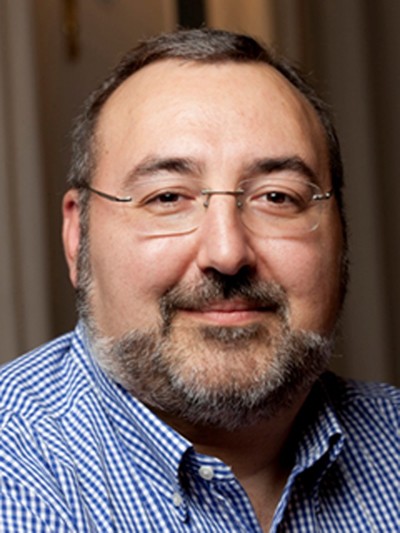LABORATORIES
Axon initial segment
Axon initial segment
Research
Team
Publications
Contact
Others
Research
The correct functioning of neuronal physiology, and therefore, of the functions of the nervous system, depends to a high degree on its morphological and functional polarization, which allows vectorial transmission of information between the dendrites and the axonal termination. Between both domains is the Axon Initial Segment (AIS) with a length of between 20 and 60 microns, being the place of generation of action potentials in response to the signals received by the neuron. This is possible due to the high concentration of voltage-gated ion channels. The initial segment of the axon is extremely important in the neuron, and neuronal physiology depends on its correct function. In addition to being the place where the nerve impulse is generated, it acts as a barrier that differentiates the somato-dendritic and axonal domains, controlling the traffic of proteins towards the axon. The dysfunction or alteration of the composition of the AIS is related to multiple diseases of the nervous system (for example: Angelman syndrome, Alzheimer’s, schizophrenia, bipolar disorder, autism, etc.), as well as injuries generated by traumatic damage to the brain or by ischemia.

The initial segment of the axon has a high degree of plasticity, being able to change its distance from the soma, its length, as well as the concentration of ion channels. These changes make it possible to adapt the amplitude and number of action potentials depending on the signal received by neurons under physiological or pathological conditions. A better knowledge of the composition and regulatory mechanisms of the AIS could generate therapeutic strategies that maintain neuronal survival and control changes in neuronal excitability associated with diseases and disorders of the nervous system.

Lines of investigation




Team

Juan José Garrido
Principal Scientist, IP of the group
Scientists
María José Benitez Moreno (UAM teacher)
Laboratory Technicians
María José Gómez
Students in training
Marta Chico Fuentes
Other students and technicians trained in the laboratory:
PhD. Students
Wei Zhang (hasta Enero 2020)
Noemí Pallas Bazarra (hasta Agosto 2015)
Mónica Tapia Pacheco (hasta Junio 2013)
Ana del Puerto del Pino (hasta Septiembre 2013)
Diana Sánchez Ponce (hasta Diciembre 2012)
Técnicos
Diana Retana
María Ciorraga
Inés Colmena
Publications
List of publications
- Extrémet J, Ramirez-Franco J, Fronzaroli-Molinieres L, Boumedine-Guignon N, Ankri N, El Far O, Garrido JJ, Debanne D, Russier M. Rescue of Normal Excitability in LGI1-Deficient Epileptic Neurons. J Neurosci. 2023 Dec 13;43(50):8596-8606. doi: 10.1523/JNEUROSCI.0701-23.2023.
- Juan José Garrido (2023). Contribution of Axon Initial Segment Structure and Channels to Brain Pathology.
Cells. 2023 Apr 21;12(8):1210. doi: 10.3390/cells12081210
- Zhang W, Ciorraga M, Mendez P, Retana D, Boumedine-Guignon N, Achón B, Russier M, Debanne D, Garrido JJ (2021). Formin Activity and mDia1 Contribute to Maintain Axon Initial Segment Composition and Structure. Mol Neurobiol. 2021 doi: 10.1007/s12035-021-02531-6.
- Zbili M, Rama S, Benitez MJ, Fronzaroli-Molinieres L, Bialowas A, Boumedine-Guignon N, Garrido JJ, Debanne D. (2021). Homeostatic regulation of axonal Kv1.1 channels accounts for both synaptic and intrinsic modifications in the hippocampal CA3 circuit. Proc Natl Acad Sci U S A. 2021 Nov 23;118(47):e2110601118. doi: 10.1073/pnas.2110601118.
- Picó S, Parras A, Santos-Galindo M, Pose-Utrilla J, Castro M, Fraga E, Hernández IH, Elorza A, Anta H, Wang N, Martí-Sánchez L, Belloc E, Garcia-Esparcia P, Garrido JJ, Ferrer I, Macías-García D, Mir P, Artuch R, Pérez B, Hernández F, Navarro P, López-Sendón JL, Iglesias T, Yang XW, Méndez R, Lucas JJ (2021). CPEB alteration and aberrant transcriptome-polyadenylation lead to a treatable SLC19A3 deficiency in Huntington’s disease. Science Transl Med. 2021;13(613):eabe7104.
- Zhang W, Bonadiman A, Ciorraga M, Benitez MJ, Garrido JJ (2019).P2Y1 Purinergic Receptor Modulate Axon Initial Segment Initial Development. Front Cell Neurosci. 2019 Apr 24;13:152. doi: 10.3389/fncel.2019.00152.
- Walton CC, Zhang W, Patiño-Parrado I, Barrio-Alonso E, Garrido JJ, Frade JM (2019).Primary neurons can enter M-phase. Sci Rep. 2019 Mar 14;9(1):4594. doi: 10.1038/s41598-019-40462-4.
- Michael Seagar, Michael Russier, Olivier Caillard, Yves Maulet, Laure Fronzaroli-Molinieres, Marina De San Feliciano, Norah Boumedine-Guignon, Léa Rodriguez, Mickael Zbili, Fabrice Usseglio, Christine Formisano-Tréziny, Fahamoe Youssouf, Marion Sangiardi, Morgane Boillot, Stéphanie Baulac, María José Benitez, Juan José Garrido, Dominique Debanne, and Oussama El Far (2017).LGI1 tunes intrinsic excitability by regulating the density of axonal Kv1 channels.Proceedings of the National Academy of Sciences (PNAS), 114 (29): 7719-7724 (2017). doi:10.1073/pnas.1618656114.
- Rama S, Zbili M, Fékété A, Tapia M, Benitez MJ, Boumedine N, Garrido JJ, Debanne D (2017). The role of axonal Kv1 channels in CA3 pyramidal cell excitability.Sci Rep. 2017 Mar 22;7(1):315. doi: 10.1038/s41598-017-00388-1.
- Tapia M*, Dominguez A, Zhang W, del Puerto A, Ciorraga M, Benitez MJ, Guaza C and Garrido JJ* (2017) Cannabinoid Receptors Modulate Neuronal Morphology and AnkyrinG Density at the Axon Initial Segment.Front. Cell. Neurosci. 11:5. doi: 10.3389/fncel.2017.00005. *Corresponding authors
- Diez H, Benitez MJ, Fernandez S, Torres-Aleman I, Garrido JJ*, Wandosell F*.Class I PI3-kinase or Akt inhibition do not impair axonal polarization, but slow down axonal elongation.Biochim Biophys Acta. 2016 Nov;1863(11):2574-2583. *Corresponding authors
- Del Puerto A, Fronzaroli-Molinieres L, Perez-Alvarez MJ, Giraud P, Carlier E, Wandosell F, Debanne D, Garrido JJ. ATP-P2X7 Receptor Modulates Axon Initial Segment Composition and Function in Physiological Conditions and Brain Injury.Cereb Cortex. 2015 Aug;25(8):2282-94.
- Benitez MJ, Sanchez-Ponce D, Garrido JJ*, Wandosell F*. Hsp90 activity is necessary to acquire a proper neuronal polarization.Biochim Biophys Acta. 1843(2):245-52 (2014).(*Corresponding authors)
- Sánchez-Ponce D, DeFelipe J, Garrido JJ, Muñoz A.In vitro maturation of the cisternal organelle in the hippocampal neuron’s axon initial segment.Mol Cell Neurosci. 2011 Sep;48(1):104-16.
- Del Puerto A, Wandosell F and Garrido JJ (2013)Neuronal and glial purinergic receptors functions in neuron development and brain disease.Front. Cell. Neurosci. 7:197: 1-15
- Simon D, Herva ME, Benitez MJ, Garrido JJ, Rojo AI, Cuadrado A, Torres JM, Wandosell F.Dysfunction of the PI3K-Akt-GSK-3 pathway is a common feature in cell culture and in vivo models of prion disease.Neuropathol Appl Neurobiol. 2013 Jun 6. doi: 10.1111/nan.12066.
- Varea O, Escoll M, Diez H, Garrido JJ, Wandosell F.Oestradiol signalling through the Akt-mTORC1-S6K1.Biochim Biophys Acta. 2013 May;1833(5):1052-64.
- Tapia M, Del Puerto A, Puime A, Sánchez-Ponce D, Fronzaroli-Molinieres L, Pallas-Bazarra N, Carlier E, Giraud P, Debanne D, Wandosell F, Garrido JJ.GSK3 and β-catenin determines functional expression of sodium channels at the axon initial segment.Cell Mol Life Sci. 2013 Jan;70(1):105-20.
- Sánchez-Ponce D, DeFelipe J, Garrido JJ, Muñoz A.Developmental expression of Kv potassium channels at the axon initial segment of cultured hippocampal neurons.PLoS One. 2012;7(10):e48557.
- Garrido JJ.Vascular endothelial growth factor and HDAC 6: a neuroprotective signalling pathway against cancer therapy-induced neuropathy.Brain. 2012 Sep;135(Pt 9):2579-80.
- Diez H, Garrido JJ, Wandosell F.Specific roles of Akt iso forms in apoptosis and axon growth regulation in neurons. PLoS One. 2012;7(4):e32715. Epub 2012 Apr 11.
- Del Puerto A, Díaz-Hernández JI, Tapia M, Gomez-Villafuertes R, Benitez MJ, Zhang J, Miras-Portugal MT, Wandosell F, Díaz-Hernández M, Garrido JJ. Adenylate cyclase 5 coordinates the action of ADP, P2Y1, P2Y13 and ATP-gated P2X7 receptors on axonal elongation. J Cell Sci. 2012 Jan 1;125(Pt 1):176-88.
- Díaz-Hernandez JI, Gomez-Villafuertes R, León-Otegui M, Hontecillas-Prieto L, Del Puerto A, Trejo JL, Lucas JJ, Garrido JJ, Gualix J, Miras-Portugal MT, Díz-Hernandez M.In vivo P2X7 inhibition reduces amyloid plaques in Alzheimer’s disease through GSK3β and secretases.Neurobiol Aging. 2012 Aug;33(8):1816-28.
- Sánchez-Ponce D, Blázquez-Llorca L, Defelipe J, Garrido JJ, Muñoz A.Colocalization of α-actinin and Synaptopodin in the Pyramidal Cell Axon Initial Segment.Cereb Cortex. 2012 Jul;22(7):1648-61
- Miguel Medina, Juan José Garrido, Francsico WandosellModulation of GSK-3 as a therapeutic strategy on tau pathologies Frontiers in Molecular Neuroscience, September 2011, Volume 4 Article 24
- Franco A, Knafo S, Banon-Rodriguez I, Merino-Serrais P, Fernaud-Espinosa I, Nieto M, Garrido JJ, Esteban JA, Wandosell F, Anton IM. WIP is a negative regulator of neuronal maturation and synaptic activity. Cereb Cortex. 2012 May;22(5):1191-202.
- Sánchez-Ponce D, DeFelipe J, Garrido JJ, Muñoz A.In vitro maturation of the cisternal organelle in the hippocampal neuron’s axon initial segment.Mol Cell Neurosci. 2011 Sep;48(1):104-16.
- Sanchez-Ponce D, Muñoz A, Garrido JJ.Casein kinase 2 and microtubules control axon initial segment formation.Mol Cell Neurosci. 2011 Jan; 46(1):222-34.
- Tapia M, Wandosell F, Garrido JJ.Impaired Function of HDAC6 Slows Down Axonal Growth and Interferes with Axon Initial Segment Development.PLoS ONE 5(9): e12908 (2010).
- Varea O, Arevalo MA, Garrido JJ, Garcia-Segura LM, Wandosell F, Mendez P. Interaction of estrogen receptors with insulin-like growth factor-I and Wnt signaling in the nervous system.Steroids.75 (8-9): 565-9. (2010). Review.
- Gómez-Villafuertes, Rosa; del Puerto, Ana; Díaz-Hernández, Miguel; Bustillo, Diego; Díaz-Hernández, Juan; Huerta, Paula; Artalejo, Antonio; Garrido, Juan José; Miras-Portugal, Mª Teresa. Ca2+/calmodulin-dependent kinase II signalling cascade mediates P2X7 receptor-dependent inhibition of neuritogenesis in neuroblastoma cells.FEBS Journal. 276(18):5307-25 (2009).
- Varea O, Garrido JJ, Dopazo A, Mendez P, García-Segura LM, Wandosell F.Estradiol activates beta-catenin dependent transcription in neurons. PLoS ONE. 2009;4(4):e5153. Epub 2009 Apr 10.
- Miguel Díaz-Hernandez, Ana del Puerto, Juan Ignacio Díaz-Hernandez, María Diez-Zuera, José Javier Lucas, Juan José Garrido, María Teresa Miras-Portugal. Inhibition of the ATP-gated P2X7 receptor promotes axonal growth and branching in cultured hippocampal neurons.Journal of Cell Science, 121, 3717-3728 (2008). primeros autores, autores para correspondencia.
- Sanchez-Ponce D, Tapia M, Muñoz A, Garrido JJ. New role of IKKalpha/beta phosphorylated IkappaBalpha in axon outgrowth and axon initial segment development. Mol Cell Neurosci. 37: 832-844 (2008).
- Simón D, Benitez MJ, Gimenez-Cassina A, Garrido JJ, Bhat RV, Díaz-Nido J, Wandosell F.Pharmacological inhibition of GSK-3 is not strictly correlated with a decrease in tyrosine phosphorylation of residues 216/279. J Neurosci Res. 86(3):668-74, (2008).
- Garrido J.J., Simón, D., Varea, O. Wandosell, F.GSK3 alpha and GSK3 beta are neccessary for axon formation. FEBS. Lett., 58(8):1579-1586 (2007).
- Simón D., Varea O., Garrido J.J. y Wandosell F.Role of GSK-3/Shaggy in neuronal cell biology. Glycogen Synthase Kinase-3 (GSK-3) and its inhibitors. páginas 45-60.Editado por Wiley & Sons (2006).
- Fache M.P., Moussif A., Fernandes F., Giruad P., Garrido J.J. y Dargent B.Endocytic elimination and domain selective tethering confer protein segregation at the axonal initial segment.Journal of Cell Biology, 166,: 571- 578 (2004).
- Garrido J.J., Fernandes F., Moussif A., Fache M.P., Giraud P. y Dargent B.Dynamic compartmentalization of the voltage-gated sodium channels in axons (Review).Biology of the Cell, 95, 437-445 (2003).
- Garrido J.J., P. Giraud, E. Carlier, F. Fernandes, A. Moussif, M.P. Fache, D. Debanne y B. Dargent.A targeting motif involved in sodium channel clustering at the axonal initial segment. Science, 300, 2091-2094 (2003).
- Garrido J.J., Fernandes F., Giraud P., Mouret I., Pasqualini E., Fache M., Jullien F. y Dargent B.Identification of an axonal determinant in the C-terminus of the sodium channel Nav1.2.EMBO Journal, 20, 5950- 5961 (2001).
- Carnicero E., Garrido J.J., Alonso M.T. y Schimmang T.Roles of fibroblast growth factor 2 during innervation of the avian inner ear.Journal of Neurochemistry, 77, 786- 795 ( 2001).
- Berton F., Cornet V., Iborra C., Garrido J.J., Dargent B., Fukuda M., Seagar M. y Marquèze B. Synaptotagmin I and IV define distinct populations of neuronal transport vesicles. European Journal of Neuroscience, 12, 1294-1302 (2000).
Contact
Where to find us
Initial Segment of the Axon Research Group
Instituto Cajal CSIC. Avda. Doctor Arce, 37. 28002. Madrid
Llámanos
Phone number:
Write us
Email address:
Others
Granted projects
- Axon initial segment dysfunction and early neurodegeneration: glial and neuronal mechanisms in a model of Alzheimer’s disease
Reference: PID2021-123140NB-I00 (09/01/2022 – 08/31/2025).
IP: Juan José Garrido Jurado. Cajal Institute, CSIC
Financing Entity: MINISTRY OF SCIENCE and INNOVATION
- Axon Initial Segment Plasticity and Integrity: Regulatory mechanisms, role in brain disease and prevention.
Reference: RTI2018-095156-B-I00 (01/01/2019 – 08/31/2022).
IP: Juan José Garrido Jurado. Cajal Institute, CSIC
Financing Entity: MINISTRY OF SCIENCE, INNOVATION AND UNIVERSITIES
- Plasticity, dysfunction and repair of the Axon Initial Segment in SNC diseases and brain damage: Role of purinergic and cannabinoid systems.
Reference: SAF2015-65315-R (01/01/2016 – 12/31/2018)
IP: Juan José Garrido Jurado. Cajal Institute, CSIC
Financing Entity: Ministry of Economy and Competitiveness
- Developmental and functional control of the Axon Initial Segment and nodes of Ranvier by PI3k/Akt/GSK3 and calcium: role in psychiatric and neurodegenerative diseases.
Reference: SAF2012-39148-C03-03 (01/01/2013 – 12/31/2015)
IP: Juan José Garrido Jurado. Cajal Institute, CSIC
Financing Entity: Ministry of Economy and Competitiveness
- CIBERNED Group (CIBER NEURODEGENERATIVE DISEASES): MOLECULAR MECHANISMS OF NEURODEGENERATION (CB06/05/0067).
Principal Investigators: PI: Francisco Wandosell Jurado, Co-PI: Juan José Garrido Jurado
Yearly competitive funding.
Funding agency: Carlos III Health Institute (ISCIII)
Doctoral Thesis
- Wei Zhang.
Axon Initial Segment cytoskeleton: Composition and plasticity regulation by formins. Universidad Autónoma de Madrid (2019) Director de Tesis: Juan José Garrido Jurado. Calificación: Cum laude.
- Noemí Pallas Bazarra
Estudio del papel de la proteína TAU en la modulación de la neurogénesis hipocampal adulta Universidad Autónoma de Madrid (2015) Directores de Tesis: Juan José Garrido Jurado, Felix Hernández y María Llorens. Calificación: Cum laude
- Ana María Del Puerto del Pino.
Modulación de la elongación axonal y la excitabilidad neuronal por receptores purinérgicos P2Y1, P2Y13 y P2X7. Universidad Autónoma de Madrid (2013). Director de Tesis: Juan José Garrido Jurado. Calificación: Cum laude.
- Mónica Tapia Pacheco.
Función de HDAC6 y beta-catenina en la maduración funcional del segmento inicial del axón. Universidad Autónoma de Madrid (2012). Director de Tesis: Juan José Garrido Jurado. Calificación: Cum laude.
- Diana Sanchéz Ponce.
Composición y mecanismos moleculares en el desarrollo del segmento inicial del axón. Universidad Complutense de Madrid (2012). Codirectores de Tesis: Juan José Garrido Jurado y Alberto Muñoz Cespedes. Calificación: Cum laude.
Patents
USE OF P2X7 RECEPTOR ANTAGONISTS TO PROMOTE AXONAL GROWTH AND BRANCHING.
Authors: María Teresa Miras Portugal, Juan José Garrido Jurado, Miguel Díaz Hernández.
Owner Entity: Complutense University of Madrid and Higher Council for Scientific Research.
Patent No.: PCT/ES2009/070288
Collaborations
- Dr. Francisco Wandosell, Centro de Biología Molecular “Severo Ochoa”, CSIC-UAM.
- Dominique Debanne, Unité de Neurobiologie des canaux Ioniques et de la Synapse (UNIS). UMR_S1072, INSERM – AMU. Marsella, Francia.

Neuroscience Research Center dependent on the CSIC. Founded in 1920 and initially directed by Santiago Ramón y Cajal. World reference in the study of the brain. Custodian of the Cajal Legacy.
Activities
